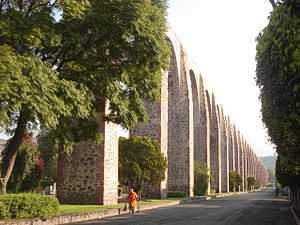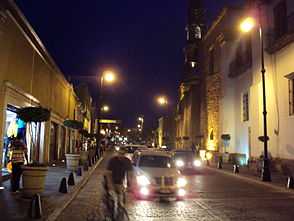Bajío

The Bajío (lowlands) is a region of Central Mexico that includes parts of the states of Guanajuato, Querétaro, Aguascalientes and Jalisco.[1][2][3]
The Bajío has repeatedly been recognized as the region with the best quality of life and most safest region in Mexico[4] also the most dynamic in Latin America.[5][6] Nowadays, is a vigorous service region that is experiencing an ongoing social and economic revitalization. It is a strong business and economic centre.[7][8]
The largest cities of Bajio are León, Santiago de Queretaro and Aguascalientes.[9]
Economy
Today, the region is one of the fastest-growing in the country. This has caused the metropolitan areas to attract many migrants from other parts of Mexico.[10][11][12]
The region has had an outstanding industrial and economic development in the last 15 years. The cities of Bajío has one of the highest income per capita in Mexico.[13]


Demography
Largest cities
| Rank | City | Population |
|---|---|---|
| 1 | León | 1 609 717 |
| 2 | Santiago de Querétaro | 1 097 028 |
| 3 | San Luis Potosí | 1 040 822 |
| 4 | Aguascalientes | 932 298 |
| 5 | Irapuato | 529 979 |
| 6 | Celaya | 468 387 |
| 7 | Salamanca | 260 769 |
| 8 | Guanajuato | 260 769 |
| 9 | San Juan del Río | 190 878 |
| 10 | Lagos de Moreno | 150 157 |
| 11 | Tepatitlán | 149 000 |
Geography
In general parlance, it is usually associated with the States of Guanajuato and Querétaro, although it only forms a part of them. It is characterized by its highly mechanized agriculture, with mean precipitation in the order of 700 millimetres (28 in) per annum (one of the highest in the country). During the Viceroyalty of New Spain, the area was known as the breadbasket of the territory. Up until today (21st Century's second decade), the region produces sorghum, wheat and maize as its main crops.
Culture
The Bajío is known for being the cradle of Mexican Independence from Spanish Empire and one of the most conservative bastions of Mexican Catholicism. The Bajío is where in April 1915, during the Mexican Revolution, General Álvaro Obregón provoked decisive battles against Pancho Villa. Villa's troops lost in June outside Celaya.
Pre-historic Bajío culture
Recent archaeological studies of the Bajío have discovered an extensive, pre-historic cultural tradition unique to the region, particularly along the flood plains of the Lerma and Laja rivers. The Bajío Culture flourished from 300 to 650CE, with cultural centers ranging from El Cóporo in the far north of Guanajuato to Plazuelas in the far south west. More than 1,400 sites have been discovered throughout the state of Guanajuato, with only the sites of Cañada de la Virgen, El Cóporo, Peralta, and Plazuelas having received extensive study.
See also
References
- ↑ http://www.europeanceo.com/finance/2014/01/entrada-group-at-the-heart-of-mexicos-thriving-manufacturing-industry/
- ↑ http://www.am.com.mx/leon/negocios/se-afianza-en-el-bajio-cluster-de-autopartes-74588.html
- ↑ http://www.elfinanciero.com.mx/secciones/finanzas/49172-caen-25-las-remesas-familiares-en-el-bajio.html
- ↑ http://www.ags.itesm.mx/campus/historia_ciudad.htm
- ↑ http://noticieros.televisa.com/economia/1308/region-bajio-el-detroit-mexicano-le-figaro/
- ↑ http://t21.com.mx/opinion/bitacora/2013/08/16/bajio-nuevo-milagro-mexicano
- ↑ http://www.stratfor.com/sample/image/developing-mexicos-bajio-region
- ↑ http://www.stratfor.com/sample/analysis/mexico-new-manufacturing-heartland
- ↑ http://www.roughguides.com/destinations/north-america/mexico/baj%C3%ADo/
- ↑ "Junto Con El Crecimiento De La Ciudad, Crecen También Los Servicios Públicos Municipales Con Calidad En Beneficio De Los Habitantes Del Municipio" [Together with the growth of the city, grow also the municipal public services with quality to Benedit the inhabitants of the municipality] (in Spanish). Querétaro: Municipality of Querétaro. 2007-07-30. Retrieved 2009-11-12.
- ↑ http://amqueretaro.com/2013/08/queretaro-emblema-de-mexico-le-figaro/.html
- ↑ http://www.excelsior.com.mx/nacional/2013/06/02/902058
- ↑ http://www.datacenterdynamics.es/focus/archive/2013/02/quer%C3%A9taro-atrae-los-centros-de-datos
- http://www.cuentame.inegi.org.mx/territorio/rev/index.html
- http://www.inegi.org.mx/sistemas/mexicocifras/default.aspx?e=11&i=i
- http://www.e-local.gob.mx/work/templates/enciclo/guanajuato/hist.htm
- http://www.historicas.unam.mx/moderna/ehmc/ehmc14/187.html
- Wright Carr, David Charles (1999): La conquista del Bajío y los orígenes de San Miguel de Allende, Universidad del Valle de México-Fondo de Cultura Económica, México.
- http://www.bicentenario.gob.mx/bdb/bdbpdf/NBNM/R/23.pdf
- Ignacio Ocaranza Sainz, Estudio geográfico y económico del Bajío, Universidad Nacional Autónoma de Mexico, 1963
| Wikivoyage has a travel guide for Bajío. |
Coordinates: 20°28′24″N 101°12′02″W / 20.473335°N 101.200562°W